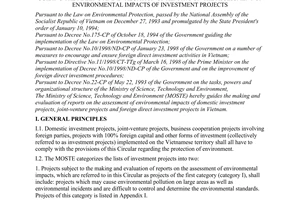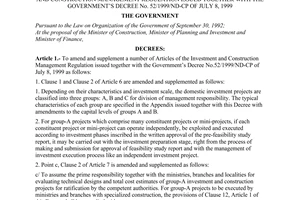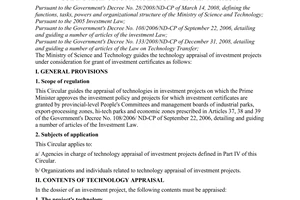Circular No.55/2002/TT-BKHCNMT of July 23, 2002 guiding the technological and environmental evaluation of investment projects đã được thay thế bởi Circular No. 10/2009/TT-BKHCN of April 24, 2009, guiding technology appraisal of investment projects. và được áp dụng kể từ ngày 08/06/2009.
Nội dung toàn văn Circular No.55/2002/TT-BKHCNMT of July 23, 2002 guiding the technological and environmental evaluation of investment projects
|
THE
MINISTRY OF SCIENCE, TECHNOLOGY AND ENVIRONMENT |
SOCIALIST
REPUBLIC OF VIET NAM |
|
Hanoi, July 23, 2002 |
CIRCULAR
GUIDING THE TECHNOLOGICAL AND ENVIRONMENTAL EVALUATION OF INVESTMENT PROJECTS
Pursuant to the Government’s
Decree No.22/CP of May 22, 1993 on the tasks, powers and organizational
structure of the Ministry of Science, Technology and Environment;
Pursuant to the Government’s Decree No.24/2000/ND-CP of July 31, 2000
detailing the implementation of the Law on Foreign Investment in Vietnam;
Pursuant to the Government’s Decree No.51/1999/ND-CP of July 8, 1999
detailing the implementation of the Law on Domestic Investment Promotion
(hereinafter called Decree No.51/1999/ND-CP) and Decree No.35/2002/ND-CP of
March 29, 2002 amending and supplementing Lists A, B and C promulgated in the
Appendix to Decree No.51/1999/ND-CP;
Pursuant to the Government’s Decree No.52/1999/ND-CP of July 8, 1999 issuing
the Regulation on Investment and Construction Management and Decree
No.12/2000/ND-CP of May 5, 2000 amending and supplementing a number of articles
thereof;
Pursuant to the Government’s Decree No.175/CP of October 18, 1994 guiding
the implementation of the Law on Environment Protection,
The Ministry of Science, Technology and Environment issues this Circular
guiding the technological and environmental evaluation of investment projects
being at the stage of consideration for investment licenses.
I. GENERAL PROVISIONS
1. Technological and environmental evaluation of investment projects
a/ Technological evaluation of investment projects means the process of examining and assessing the compatibility of technologies mentioned in the projects with their objectives and contents on the basis of the State’s undertakings, policies and plannings available at the time of project evaluation.
b/ Environmental evaluation of investment projects means the examination and assessment of the projects impacts on the environment, and measures to minimize the adverse impacts on the environment according to the State’s current regulations on environment protection.
Based on the results of examination and assessment mentioned at Points a and b above, to propose the competent agencies to grant or not to grant investment licenses (for foreign investment projects) or to decide on or accept the investment (for domestic investment projects), and other matters (if any) which should be notified to the project owners.
2. Evaluation objects
a/ Foreign investment projects defined in the Government’s Decree No.24/2000/ND-CP of July 31, 2000 detailing the implementation of the Law on Foreign Investment in Vietnam.
b/ Domestic investment projects defined in the Government’s Decree No.51/1999/ND-CP of July 8, 1999 detailing the implementation of the Law on Domestic Investment Promotion, Decree No.52/1999/ND-CP of July 8, 1999 issuing the Regulation on Investment and Construction Management and Decree No.12/2000/ND-CP of May 5, 2000 amending and supplementing a number of articles of the Regulation on Investment and Construction Management.
3. Contents of the technological and environmental evaluation of investment projects
a/ Products of technologies and their outlets.
b/ Technology selection.
c/ Equipment in the technological chains.
d/ Raw materials, fuel, materials, components and spare parts for production.
e/ Location selection.
f/ Technology transfer.
g/ The projects impacts on the environment.
h/ The projects efficiency.
i/ Other relevant matters (if any).
II. DETAILS OF THE TECHNOLOGICAL AND ENVIRONMENTAL EVALUATION OF INVESTMENT PROJECTS
In a project dossier, the following contents should be evaluated:
1. Products of technology(ies) and their outlets
a/ Forecasts on the market (domestic and overseas) demand, taking into account products of the same kind and the forecasts reliability.
b/ Forecasts on the market shares of the technology’s products, their export percentages and marketing methods.
c/ The technological scale’s rationality and equipment’s required capacity.
d/ The products quality standards.
e/ The competitiveness (in terms of quality, design and price) of the technology’s products.
2. Technology selection
a/ Examining the perfection of technology(ies): The applied technology(ies) must show their stability and have already been commercialized. Depending on the kinds of product and production methods, the technological diagrams may vary but must fully demonstrate all processes of the production chain aiming to create products with expected quantity and quality.
b/ Examining the modernity of the technological chain: A modern technological chain is a specialized production chain organized by the mechanization method, in which at least 1/3 (one third) of automatic equipment is program-controlled and exist no hard manual-labor processes; the production chain is arranged in a space ensuring industrial hygiene, labor safety and environmental sanitation standards. The enterprise management system must be an advanced system (where a number of jobs are computerized, such as: technology and materials management, marketing...).
c/ Encouraging the application of modern technologies based on the above-mentioned concept of a modern technological chain. However, in a number of particular cases, technologies may be applied in compatibility with the production level and conditions of our country or localities where the projects are carried out. When such technologies are applied, their advantages and compatibility should be clearly explained.
d/ Selecting technology(ies): In an investment project, there may be one or many technological options. If there are many technological options, advantages and disadvantages of each option should be compared, and the perfection of technology(ies), the modernity of the technological chain as well as the technological compatibility should be examined, which shall serve as basis for commenting on the selected technological option.
3. Equipment in technological chains
a/ Evaluation of the equipment’s suitability:
- The equipment in a technological chain must be examined on the basis of their specifications and quality, which must meet the technological requirements in order to create products with expected quantity and quality.
- The equipment must be complete, that is the list of equipment must demonstrate the capability of implementing the processes in the technological diagram, meeting the quantitative and qualitative requirements of products. Attention should be paid to avoiding the lack of equipment necessary for the production chain or the inclusion of unnecessary equipment into the list (which may happen when one of the parties contributes capital to the project with equipment).
b/ Assessment of the equipment’s quality:
On the basis of the list of equipment of an investment project, it is necessary to examine:
- The equipment’s origin (the manufacturing country and company).
- The equipment’s year of manufacture, sign and code.
- Its specifications and technical properties.
- The quality criteria of products turned out by the equipment.
c/ The equipment procurement method: bidding or not? reasons therefor?
d/ Assessment of the equipment’s novelty:
To encourage the use of brand-new equipment in the investment projects. Where it is necessary to import used equipment, such must strictly comply with the current law provisions.
4. Raw materials, fuel, materials, components and spare parts for production
a/ Examining the capability of exploiting, transporting and preserving raw materials and materials to be supplied to projects.
b/ Examining the types, volume and value of components, spare parts or semi-finished products which must be imported for product processing, assembly or manufacture. Examining the localization rate and plan to raise this rate.
c/ Examining the types, volume and value of raw materials, fuel and materials, which must be imported, and the possibility of using local and domestic raw materials as well as raw materials which scarcely cause pollution to the environment.
5. Location selection
a/ Examining the project implementation location’s suitability with the concerned technological chain.
b/ Examining and assessing the environmental advantages and disadvantages for the project implementation location.
c/ Advantages of the selected location compared to others.
6. Technology transfer
If an investment project covers one or some of the following contents (called technology transfer contents), the project owner shall be requested to compile a technology transfer contract according to law provisions (the Government’s Decree No. 45/1998/ND-CP of July 1, 1998 detailing the technology transfer:
a/ Transfer of the right to own or use industrial property objects.
b/ Transfer of technological secrets and know-hows in form of technological options, technical solutions, technological processes, preliminary and technical designs, formulas, technical parameters, drawings, technological diagrams, computer software (under technology transfer contracts), information and data on the transferred technology with or without accompanied machinery and equipment.
c/ Transfer of solutions to production rationalization and technology renewal.
d/ Provision of services in support of technology transfer:
- Providing technical support in technology selection, guiding equipment installation and trial operation of equipment chains.
- Providing consultancy on technology management, business management, and guiding the implementation of the transferred technological processes.
- Training and fostering workers, technicians and managerial cadres to raise their professional and managerial skills so that they may firmly grasp the transferred technology(ies).
e/ Supply of machinery, equipment and technical facilities together with one or some of the above-mentioned contents.
7. The project’s impacts on the environment:
a/ Examining factors which may adversely impact the environment: Polluting sources from production stages; solid, liquid and gaseous wastes discharged in the production process, etc.
b/ Examining the latent danger of environmental incidents.
c/ Examining handling measures to minimize adverse impacts on the environment as well as measures to prevent environmental incidents.
d/ Categorizing projects for which reports on the assessment of environmental impacts must be elaborated (category-I projects) or written registration of compatibility with environmental standards must be made (category-II projects), on the basis of the Science, Technology and Environment Ministry’s Circular No. 490/TT-BKHCNMT of April 29, 1998 guiding the elaboration and evaluation of reports on the assessment of environmental impacts for investment projects.
8. The projects efficiency
When assessing a project’s efficiency, taking into account the technology’s contributions, it is necessary to examine the following aspects:
a/ The socio-economic benefits brought about by the project (the possibilities of generating new production capacity, new production and business lines and new products; expanding markets, creating jobs for laborers and remittances to the State budget, and economic benefits of the project owner, etc.)
b/ Examining the project’s financial feasibility:
- The time for capital recovery.
- The net present value (NPV).
- The internal rate of return (IPR).
9. Other relevant matters (if any)
Apart from the main task of technological and environmental evaluation, attention should also be paid to considering and commenting on other relevant matters, such as:
a/ The project’s objectives:
- Examining the investment’s necessity.
- Examining the compatibility of the projects objectives with the State’s undertakings, policies and plannings.
b/ Labor and training:
- Examining the enterprises employment plans. Giving priority to the recruitment of Vietnamese laborers (except for special positions which require foreign laborers). Encouraging projects, which create more jobs for Vietnamese laborers.
- Examining training plans (domestic and overseas) for Vietnamese laborers according to the contents and requirements of each position in the technological chain.
c/ Labor safety and hygiene, fire and explosion prevention and fighting:
- Examining labor safety and hygiene: labor protection equipment and devices, labor safety and hygiene, suited to each position in the technological chain.
- Examining fire and explosion prevention and fighting: equipment and devices for fire and explosion prevention, and other relevant necessary equipment, which must comply with the designs under current regulations.
d/ The project owner’s professional and financial capacities as well as legal person status, etc.
III. METHODS OF EVALUATING INVESTMENT PROJECTS
Depending on the requirements for each project, the evaluation may be conducted by one of the following methods:
a/ Evaluation by experts:
This method shall apply to the following cases:
- The investment project technological contents are clear.
- The project falls in a specific domain or the concerned branches opinions thereon are quite clear.
- The evaluators are knowledgeable about the field of operation of the investment project.
b/ Consulting specialists:
This method shall apply to the following cases:
- The evaluators are knowledgeable about the field of operation of the investment project but lack information, thereby needing to consult specialists in order to update information.
- The technological contents require profound professional knowledge and consultation with specialists in the relevant fields for adequate and accurate comments on the project.
c/ Organizing consultancy conferences:
This method shall apply to the following cases:
- The project is an inter-branch one or has wide-ranging impacts.
- The project involves complicated matters on which opinions remain divergent.
IV. ORGANIZATION OF IMPLEMENTATION
1. The Ministry of Science, Technology and Environment shall organize the technological and environmental evaluation of group-B and -C investment projects (except for the decentralized group-B projects). The Office in charge of technological and environmental evaluation of investment projects shall be the major unit to organize the evaluation.
2. The science, technology and environment-managing organizations of the ministries and branches, and the Science, Technology and Environment Services of the provinces and centrally-run cities shall organize the technological and environmental evaluation of group-B and -C investment projects as decentralized or authorized.
3. Industrial parks, export-processing zones, high-tech parks, corporations 90 and 91 shall conduct the technological and environmental evaluation of group-B and -C investment projects as decentralized or authorized to license the investment.
V. IMPLEMENTATION PROVISIONS
1. This Circular takes effect 15 days after its signing and replaces Circular No.1940/TT-BKHCNMT of November 15, 1997 of the Ministry of Science, Technology and Environment guiding the technological evaluation of investment projects being at the stage of consideration for investment licenses.
2. If any problems, difficulties or obstacles arise in the course of implementation, they should be promptly reported to the Ministry of Science, Technology and Environment for study and settlement.
|
MINISTER OF SCIENCE, TECHNOLOGY
AND ENVIRONMENT |










